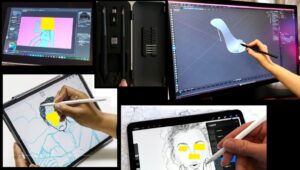5 Mistakes RUINING Your Digital Art (Drawing Tablet Secrets!)
Bigger drawing tablets offer more drawing space and shortcut keys, ideal for professional graphic design. Choose a tablet with a high-resolution display and a pressure-sensitive stylus for precise control and color accuracy. Ensure compatibility with your design software, with iPads offering a slight advantage in app optimization.
CONTENTS: 5 Mistakes RUINING Your Digital Art
- Choosing the right drawing tablet
- Drawing tablet size matters
- Bigger tablet, more features
- Tablet screen & stylus matter most
- Software compatibility matters

Choosing the right drawing tablet
5 Mistakes RUINING Your Digital Art
If you’re serious about graphic design, having a drawing tablet is crucial. Whether you opt for a standalone graphics tablet connected to a computer, a pen display with its own screen, or a tablet computer, these tools are essential for realizing your design concepts digitally. The key question becomes: how do you choose the right drawing tablet?
In the past, Wacom dominated the market as the go-to choice for dedicated drawing tablets. Known for their exceptional build quality and extensive software compatibility, Wacom tablets were considered the top option. However, competitors such as XP-Pen, Huion, and Xencelabs have emerged, offering compelling alternatives. These brands often provide similar features at notably lower prices compared to Wacom, which is known for its premium pricing. For a comprehensive overview, refer to our guide on the best drawing tablets.
Drawing tablet size matters
5 Mistakes RUINING Your Digital Art: Additionally, there’s competition from traditional tablets like those from Apple and Samsung. Advances in stylus and display technology have made these tablets effective tools for digital art, leading many designers to switch to devices like the iPad Pro. For a detailed comparison of pen tablets, pen displays, and tablets, check out our guide. Now, let’s focus on how to select the right tablet for graphic design.
A fundamental consideration is the size of the drawing tablet you prefer. In drawing and graphic design, a larger tablet offers obvious advantages. More drawing surface allows for greater freedom, especially for creating long, sweeping lines. Therefore, choosing a tablet with a decent-sized canvas is crucial for these tasks.
Bigger tablet, more features
Drawing tablets come in various configurations, with their display size measured in diagonal inches, similar to smartphones or regular tablets. Many designers suggest that for professional use, a tablet with a screen size of at least 16 inches is preferable. Some professional tablets are even larger, such as Wacom’s Cintiq 27, which boasts a 27-inch display. While larger displays offer more workspace, they also make the tablet bulkier and less portable.
Another benefit of larger tablets is the availability of more space for physical shortcut keys. Both graphics tablets and pen displays typically feature assignable shortcut keys that can be customized to control preferred functions or tools. This capability significantly speeds up graphic design workflows, a feature notably absent in regular tablets like iPads. In newer models, some tablets have replaced shortcut keys on the bezel with a separate dedicated remote featuring shortcut buttons.
Tablet screen & stylus matter most
5 Mistakes RUINING Your Digital Art: When choosing a drawing tablet with a built-in screen, the quality of the display is crucial. It should offer high resolution for clear viewing of your creations and accurate color representation. Professional-grade tablets should be capable of displaying colors across various gamuts such as RGB, sRGB, NTSC, DCI-P3, ensuring fidelity in your work. Some designers opt for screenless graphics tablets and invest in high-quality monitors known for their color accuracy instead.
The stylus is equally important in the digital drawing tablet setup. Different tablets support different styluses, often bundled with the device (except for Apple’s iPads, where you may need to purchase the Apple Pencil separately). A good stylus for graphic design requires high pressure sensitivity, typically around 8,192 levels, which allows precise control based on how hard you press. Modern styluses like the Wacom Pro Pen 3 or Xencelabs Thin Pen meet this industry standard.
While some styluses, like those from XP-Pen, boast higher pressure sensitivity levels (up to 16,384), this may be more of a marketing feature than a necessity for most designers. Additional features to consider include tilt sensitivity, which responds to the angle of the stylus, and palm rejection, ensuring the tablet registers only the stylus tip and not accidental touches from your hand.
Moreover, the tactile feel of drawing on the tablet surface is crucial. A good drawing tablet should provide a bit of resistance (“bite”) that mimics the feel of drawing on paper with a pen or pencil, rather than a slippery surface. The subjective feel of different styluses and tablets varies, making it beneficial to try them out before purchase if possible. Borrowing from a friend or visiting a store for a demo can help you make an informed decision. Alternatively, ensure the tablet you choose has a good return policy in case it doesn’t feel right for your needs.
Software compatibility matters
5 Mistakes RUINING Your Digital Art: When selecting a drawing tablet, compatibility with your preferred design software is crucial. Historically, Wacom has maintained its dominance in this regard by offering extensive driver support, ensuring stable performance across a wide range of programs. However, other manufacturers have made significant strides in improving compatibility.
If you opt for a tablet computer such as an iPad or Galaxy Tab, it’s essential to verify that there is a compatible app available for the software you intend to use. Generally, Apple has an advantage in this area, with iOS apps often better optimized for tablets compared to Android or Windows alternatives. Additionally, Apple boasts Procreate, a popular digital drawing app exclusively available on iOS, further bolstering its appeal to digital artists.
Check out TimesWordle.com for all the latest news
You must be logged in to post a comment.